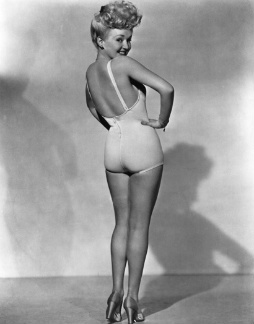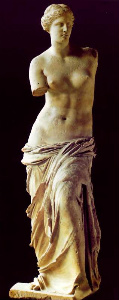While watching Metropolis in the context of the class the other day in conjunction with the readings on bodies that we did for week one and week two, some serious issues came to mind on how the body is displayed in the media. I had actually viewed the film prior to Monday's class in preparation for a costume party for which Metropolis was the theme, and obviously the event planners had also noticed the curious display of bodies in the film. What particularly resonated with me was the depiction of the main character, Maria, who especially raised questions in my mind on how the female body is portrayed in the mass media.
In the film, we see that there is a sharp divide between those living in the above city, whose carefree inhabitants spend their days in pursuit of hedonistic pleasures and leisure, and the workers living below, whose job it is to maintain the factories that keep the the other city thriving. In the privileged city, the characters are all healthy, athletic, and appear confident in their daily lives, while the factory workers walk with hunched shoulders, dragging their feet and staring at the ground in their joyless existence. However, there is a very different display of the body in Maria, who happens upon the garden party with the worker's children. She is beautiful, with perfect skin, coiffed hair, covered in make-up, and bright eyes, she carries herself with confidence and doesn't exhibit any actuality of how a woman working all day in a factory would appear. The only hint that she is different from the dancing girls in the garden is her clothing, which still highlights her well-fed, healthy figure. Its no wonder that our leading man falls for this beauty from the underworld, as she is portrayed as a strikingly beautiful "diamond" in the rough under-city.
Later on in the film, which we didn't see in class, a robot is made in the likeness of Maria, and in its creation it further exemplifies her perfect form and features. If Maria had been portrayed as a female factory worker would have actually appeared, hardly with perfectly styled hair, make-up and a dirt-free complexion, audiences would not have seen it as believable that the man who has everything would become enamored with her. She is set apart from her fellow workers in every way, her posture, her hair, her face, she is almost like a shining beacon in the grimy factory world. I find that very little has changed in society's expectations for women, especially those that are portrayed in the media.
As Susie Orbach wrote in her book Bodies, consumer culture has made having a "perfect" body an attainable goal. Girls from the time they are young are taught by society to look a certain way, to be feminine, wear high heels and dresses, do their hair and wear make-up. These attempts at perfection often have negative consequences, the female body today is supposed to be ultra-thin but curvy as well, sometimes leading to eating disorders and massive amounts of plastic surgery. There was hardly a girl that I went to high school with who didn't have or had had at one time an eating disorder of some kind. Women aren't supposed to look the way they are born, but the way that society tells them to be. I feel as though at the same time there are certain expectations of men, but rarely are such attempts at perfection followed through with the same vigour that women use in their pursuit.
In viewing the film however, I was struck by how this tied in nicely with the "Myth of Modernity" we discussed in class, as these depictions of the ideal female form are hardly something new. Even in 1927 when the film was made, women were being told that Maria was how an attractive woman looked, as she is the one who nets the male lead. If we want to go further back in time, women in art were almost always depicted as what was the ideal of the time period, be it ancient Greece or Rome or the Renaissance. This can also be related to the concept of reality versus the utopian nature of modernism that we discussed, as the film Metropolis depicts this mythical paradise in the upper city full of perfect, healthy male and female bodies. As already mentioned, Maria is hardly representational of reality, but she is this embodiment of female perfection despite her social status in the film. Media often favors this utopian view of the world when it comes to bodies, as rarely are imperfect, non-cosmetically-enhanced, "real" individuals depicted as the apex of society or even objects of desire.
Further commentary on the bodies in Metropolis can be made, one can easily see a Marxist influence in the way that the human bodies of the factory operate more as means of production rather than living beings, while the rich spend their time caroussing in the upper city. The bodies of the factory workers appear to lose all identity and become part of the machines they are working on, all for the benefit of the upper classes. Maria on the other hand, as our beautiful embodied protagonist, clearly has a voice and she stands as the only factory worker who can see that this system needs to be overthrown, and her good looks are just one more way to keep the audience focused on her. Despite the fact that this film was made over 80 years ago, little has changed in society's depiction of what is ideal and what is not, and the female body has always been the subject of exploitation and manipulation for the purpose of achieving this utopian goal.
 Betty Grable, 1940's
Sex Symbol
Betty Grable, 1940's
Sex Symbol
 Venus di Milo, embodiment of
ancient Greek female perfection
Venus di Milo, embodiment of
ancient Greek female perfection
